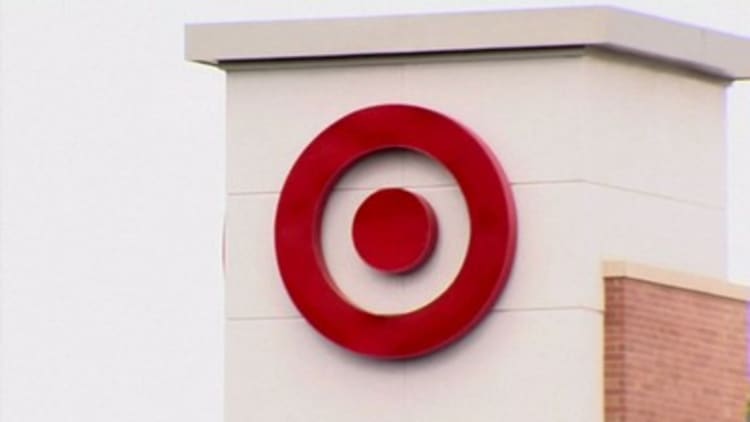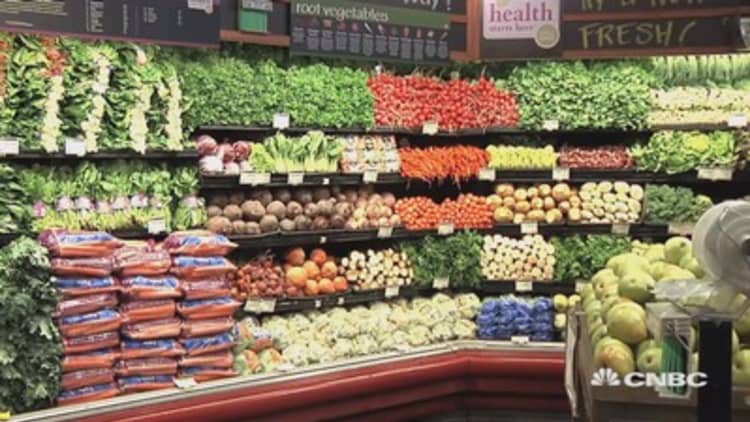
Target and Wal-Mart face many of the same headwinds in retail today, including the so-called Amazon effect, less foot traffic in stores and heated competition along the grocery aisles.
And while Wal-Mart has shown it's not afraid to spend and acquire smaller players, Target has instead focused its efforts internally, choosing to lay low and reinvest in itself.
The latest moves in the industry — Amazon encroaching into the grocery sector and announcing plans to acquire Whole Foods — is putting big-box retailer Target in an especially tough spot.
For many who closely watch retail stocks, Target seems to be keeping quiet compared with its peers. And this has more and more analysts and investors questioning Target's future.
"Target is a little lost right now, and that is worrying," said Anjee Solanki, national director of retail services at commercial real estate company Colliers International. "What does Target have up their sleeve that will make them different?"
It's no surprise the entire retail industry has taken a beating in recent months, and Target has seen its stock sink nearly 28 percent this year.
Wal-Mart, meanwhile, has been flaunting its might in grocery and digital expansion by buying Jet.com, an e-commerce site that offers consumers a taste of everything — from snack foods to women's shoes. Wal-Mart also has scooped up other sites, including men's clothing company Bonobos and outdoor retailer Moosejaw.
Target has made little apparent advancements in the same key areas — food, digital, apparel — instead remaining focused on its plan to inject $7 billion into its business over the next three years.
"Many of our competitors are aggressively rationalizing their assets," CEO Brian Cornell said when Target's investment strategy was announced in March. "They're cutting costs just to keep their heads above water. This contraction will create opportunities for Target to pick up market share over the long term."
Cornell plans to put the sizable investment toward improvements in Target's technology and supply chain and to redesign more than one-third of its existing stores.
Target's strategy of differentiating itself ... has effectively been muted.Kate McShaneCiti analyst
Target is also banking on the creation of its own brands after its success with Cat & Jack children's clothing. It hopes the exclusive merchandise will pull shoppers into stores.
"Private labels are a good strategy but not enough," Morningstar analyst John Brick told CNBC. "They should maybe continue on that path but also look for exterior angles."
Target plans to launch 12 other private-label brands over the next two years. The first, Cloud Island, launched in May and features home decor, bedding and bath items.
Time to grab a bigger piece of the grocery pie
On Tuesday, Target took its biggest step toward challenging Amazon and Wal-Mart in grocery and digital, rolling out Target Restock, a next-day delivery service of household essentials and dry grocery items. The program is starting in Minnesota, the Star Tribune reported.
Target's service costs $4.99, a dollar less than Amazon's Prime Pantry. By encouraging shoppers to buy more items in one shipment, fitting everything in a 45-pound box, this service should also help Target cut costs.
But Brick said Target needs to respond to Amazon's latest moves "quickly, or they're going to be squeezed." He suggested Target acquire Kroger or Sprouts Farmers Market in order to grow the retailer's grocery business to represent 40 to 50 percent of sales, more in line with what Wal-Mart has been able to accomplish.
But it hasn't been Target's style to make big, bold acquisitions. Target recently looked to buy direct-to-consumer mattress maker Casper, according to Recode. Instead, Target took a stake in the company earlier this month.
This investment pales in comparison with Wal-Mart's $3 billion acquisition of Jet.com last fall, as well as the slew of smaller deals it's made since.
"[Target is] more internally focused. ... They should be playing more aggressive, because Wal-Mart is beating them on the acquisition front," Brick said.
Source: Target
Target likes to point out "bright spots" in its grocery business, such as its sales of alcoholic beverages, which were highlighted on a recent earnings call. But competition in the supermarket space is only intensifying, with less market share up for grabs.
On a call with analysts and investors in May, Target chief merchandising officer Mark Tritton pointed out that value and "everyday price perception" remain challenges in Target's grocery aisles.
Trying to fix this, Target brought in Jeff Burt in April to lead the retailer's food and beverage team. Burt came to Target from Kroger, with more than 30 years of experience in the grocery industry.
But now Burt has to tackle the competition that will come from a Whole Foods-Amazon combination head on.
"The Whole Foods-Amazon deal does nothing to help Target," GlobalData managing director Neil Saunders told CNBC. "In fact, Target is much more at risk from [the deal] than Wal-Mart because it shares many more customers with both Whole Foods and Amazon than rivals."
Target really just needs to decide what it wants to do on food, Saunders said. "It seems to lack a strategy."
Looking at Target's $7 billion capital investment program, which will be spread across the company, it remains unclear how this strategy will advance the big-box retailer's grocery business specifically. So, the question remains top of Wall Street's mind.
"Food and beverage is a key category for Target, representing about 20 percent of our annual sales," Target spokesman Josh Thomas said in a statement.
"As we've shared, we are on a journey to create a differentiated experience in food and beverage. While the work won't be done overnight, we are committed to getting it right for the long term and are encouraged by the progress that we are making."
In May, CMO Tritton said Target would be sharpening its price and value messaging in grocery in the coming months, making sure the brand is more "relevant to the guest and the competitive set."
Some would argue these plans won't work.
"Target has never been a very good grocer," Bernstein analyst Brandon Fletcher told CNBC, saying the company was "late to the party" as other retailers swooped in and scooped up market share of grocery carts before Target even got a taste of the supermarket business.
Fletcher said he proposed, after Target signed a deal with CVS to open pharmaceutical stores within Target locations, that the company follow a similar path selling food. But any evidence of this sort of initiative panning out has yet to be seen, he said.
"The conversation [Target] should be having is that they're making sure what they do in price considers the fact that Whole Foods will likely have a downward movement in its prices moving forward," Fletcher said.
Wall Street should be much more cautious on Target now, given "food is a work in progress" still for the retailer, Cowen & Co. analyst Oliver Chen wrote in a recent note to clients.
"Grocery is already intensely competitive given new rock bottom pricing entrants Aldi/Lidl, WMT's commitment to price investment, and intense digital innovation at WMT," Chen wrote.
Putting the main grocery players in perspective, Wal-Mart has the biggest share of the market, with about 14.5 percent of all U.S. food and grocery sales, according to estimates and analysis from GlobalData Retail.
Kroger is next in line, with a 7.2 percent stake. And Target is smaller still, claiming 2.12 percent.
What's next for Target
One significant area of Target's investment is dedicated to refurbishing a large chunk of its existing store fleet.
The overhaul will add product vignettes and displays, which are designed to help shoppers mix and match bigger-ticket items, such as a furniture set that combines a crib, various baby products, a table and chair.
As seen in several of the updated stores in Texas, Target's food and beverage aisles are also receiving a more complete makeover that includes the addition of wood-grain fixtures, an updated floor, LED lighting and products marketed as "meal ideas."
"[F]rom what I've seen the new format just looks a bit more modern and includes a separate entrance for grocery with some convenience quick-pickup items near the entrance," GlobalData Retail's Saunders told CNBC. "It's fine, but is far from revolutionary. ... It's not differentiating them from other players in the market."
Target's saving grace could be its plans to build a fleet of smaller stores, many in bustling, urban markets. CEO Cornell has said the smaller-format stores boast a sales productivity that is roughly two times that of Target's larger, suburban-based stores.
Earlier this year, Cornell told analysts and investors about this expansion: "[W]e feel very good about our small-format strategy. As we move into new neighborhoods, we're getting better and better at curating and localizing assortments, understanding how to operate in various markets."
For the full year, Target plans to complete 100 remodels and add 30 small-format stores.
The key investments Target has been making are in its private brands, changing the supply chain to be more efficient, completing remodels of the stores, and price investments.Brandon FletcherBernstein analyst
Another key area to watch as Target revamps its stores and rolls out new brands: apparel.
Last year, Target saw the most growth in its apparel department for women's and kid's clothing, the retailer said. Earlier this year, CMO Tritton said Target saw greater potential in its men's, intimates and activewear categories.
At least one of Target's 12 new labels to launch in 2017 will likely tackle an apparel category, though it remains to be seen which one — be it swim, athleisure or another children's brand, building on the success of Cat & Jack. Target said spending on kid's apparel at its stores increased more than 50 percent in the months after the launch of Cat & Jack.
With more and more specialty apparel retailers such as J.Crew, Gymboree, Charlotte Russe and Nine West either nearing bankruptcy or already forced to file, there is a chance for Target to win a larger share of the segment. However, there's also a chance it could fall victim to headwinds that are dragging other brick-and-mortar retailers down.
Target's 12-month performance
Source: FactSet
With last week's losses, shares of Target have fallen around 25 percent over the past 12 months and are down more than 27 percent this year.
Wal-Mart's stock, meanwhile, has climbed about 5 percent over the past 12 months and is up nearly 10 percent in 2017.
Citi analyst Kate McShane recently downgraded Target to neutral from buy, slashing her projected share price to $56 apiece from $63.
McShane is worried about how quickly Target's competitors have changed the game. She expects Target will need to speed up its investments to keep pace with others that are "aggressively increasing omnichannel capabilities through acquisitions."
While Target prides itself on creating more private-label brands and curating a unique in-store experience, its same-store sales continue to lag behind Wal-Mart's and have underperformed over the past five quarters, Citi said.
"It's unclear what sort of traction these new brands will get and how much of it will be replacing private brands that might no longer be resonating with shoppers," McShane said. "TGT's strategy of differentiating itself [from peers] ... has effectively been muted."
WATCH: How Amazon's Whole Foods deal will change the US grocery business



